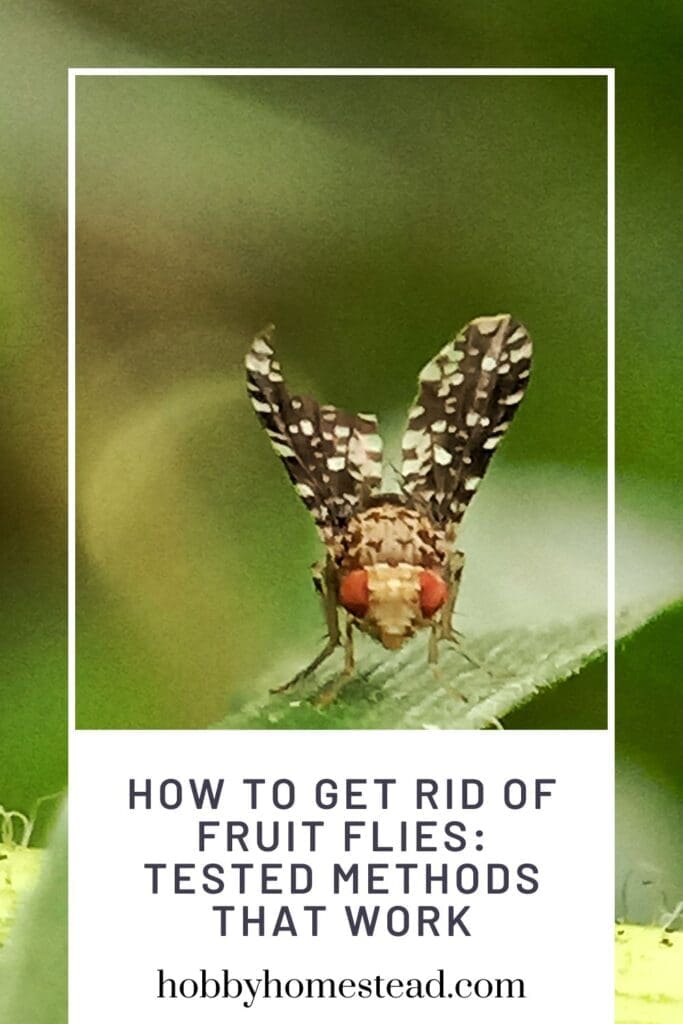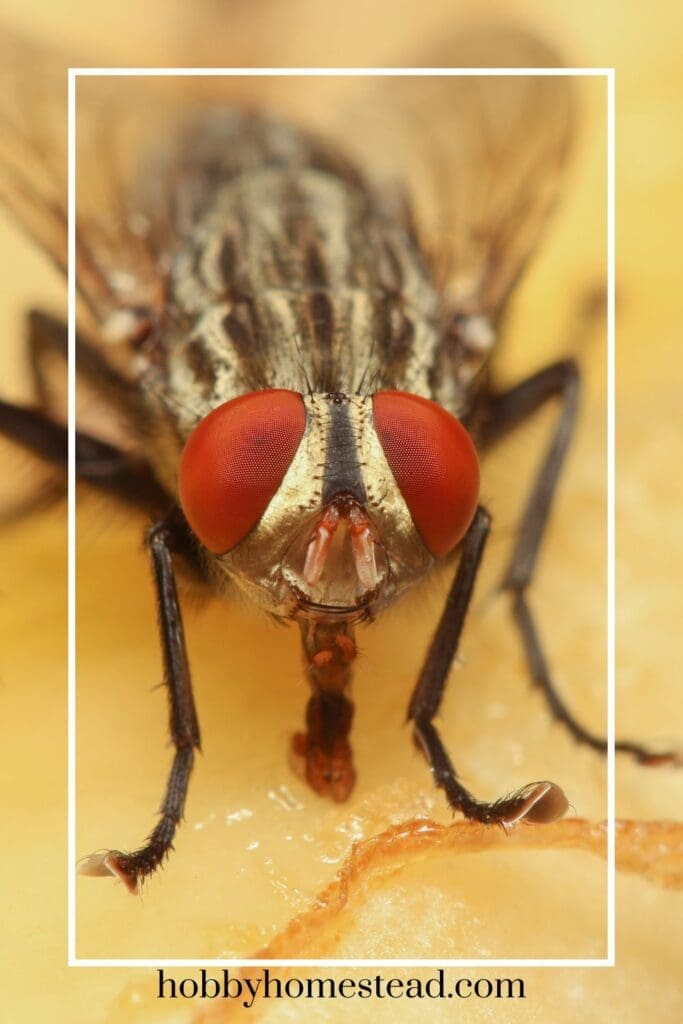How to get rid of fruit flies when you can’t figure out why they showed up in the first place? These little pests seem to quickly show up at the first signs of something rotting.
What are they?
Fruit flies, or Drosophila melanogaster, are tiny pests that seem to multiply overnight, especially around food sources like overripe fruit, garbage disposals, and compost bins.
These small flies are attracted to sugary substances and rotting produce, which act as a breeding ground for adult female fruit flies to lay batches of eggs.

Table of contents
How to spot signs of fruit fly activity in your kitchen
Spotting signs of fruit fly activity early can help you take control before they turn into a full-blown infestation. Here’s how to recognize the key indicators of fruit fly presence in your kitchen.
Look Near Food Sources
Fruit flies are small, typically around 1/8 of an inch, with red eyes and tan or brown bodies. You’ll often see them hovering around areas with food residue, like the fruit bowl, kitchen counter, or near trash cans and garbage disposals. If you spot a few small flies around these areas, it could be a sign of a growing fruit fly problem.
Clustering Around Overripe or Rotten Fruit
Fruit flies are highly attracted to the fermentation process in overripe fruit. If you notice small flies around produce left out on the counter or fruit scraps in compost bins, these could be adult fruit flies looking for a food source or a place to lay eggs.
Tiny Eggs or Larvae on Overripe Fruit or Food Residue
Fruit fly eggs and larvae are often hard to spot because they are small and transparent. Look closely at any overripe produce, food scraps, or organic material around your kitchen sink or in garbage bins. Eggs look like tiny white specks, and larvae resemble minuscule worms. If you see them, discard the produce and clean the area thoroughly.
Sightings Near Moist or Organic-Rich Environments
Fruit flies often breed in moist environments, such as kitchen sink drains, garbage disposals, and trash bins. If you spot flies around your kitchen sink or detect an increase in small flies near garbage bins, it’s a good indicator that fruit flies have found a breeding ground nearby.
Clusters Around Open Bottles or Jars with Sugary Substances
Fruit flies are also drawn to sugary substances, including wine bottles, fruit juice containers, or vinegar. If you notice them congregating around open bottles or jars, it could be a sign of a fruit fly infestation, as these items offer a reliable food source for the flies.
Unusual Activity During Warmer Months
Fruit flies are particularly active during the summer months. If you notice a sudden increase in tiny pests flying around your kitchen during late summer, it’s likely due to a rise in fruit fly activity.
Recognizing these signs can help you take quick action to clean potential breeding grounds. It’s really the best method to prevent fruit flies from spreading throughout your kitchen.
Testing Six Methods on How to Get Rid of Fruit Flies
We tried these methods to get rid of the fruit flies in my daughter’s kitchen.
Here are our top methods.
- Use the apple cider vinegar mixture, but put it in a mason jar with lid method. It is our top tip.
- The best way we found to help prevent them is using essential oils in a spray bottle. Spray on kitchen counters and it helps keep them away because they hate some of the smells.

How to Get Rid of Fruit Flies Naturally: Effective DIY Methods
If you’re struggling with a fruit fly problem, particularly during the late summer and warmer months, here are some effective methods to eliminate them naturally.
Most Important. The real game-change in fruit fly management is finding where they’re setting up shop. Without addressing the breeding source, any other measures you take will only provide temporary relief.
1. Apple Cider Vinegar Trap
One of the best ways to trap fruit flies is with an apple cider vinegar trap. Fill a small bowl with apple cider vinegar and add a couple of drops of dish soap to break the surface tension of the vinegar. The vinegar’s fermentation process attracts the flies, and the dish soap makes it impossible for them to escape. Place this bowl of vinegar near the fruit bowl or other hotspots, and within a couple of days, you should see fewer fruit flies.
2. Plastic Wrap Trap
This DIY fruit fly trap is another simple yet effective solution. Put some fruit juice or a piece of fruit in a small bowl, cover it tightly with plastic wrap, and poke a few small holes with a toothpick.
Fruit flies can get in but have trouble getting out. You can also use white vinegar if you don’t have fruit juice. This plastic wrap trap works well on the kitchen counter near any sources of food residue.
3. Red Wine Trap
A small bowl of red wine mixed with a few drops of dish soap can be an effective trap, similar to the apple cider vinegar trap. Fruit flies are attracted to the aroma, and the dish soap traps them once they land. This trap is ideal to set near kitchen sinks or recycling bins where adult fruit flies are likely to hover.
4. Essential Oils as Repellents
Certain essential oils, like lavender, eucalyptus, and peppermint, can help repel fruit flies. Mix a few drops of essential oils with water in a spray bottle and spritz the mixture around your kitchen counter, fruit bowl, or near garbage bins. This natural method helps to create an unpleasant environment for the flies without using harsh chemicals.
5. Paper Cone and Fruit Trap
To make a paper cone trap, place a piece of overripe fruit or fruit scraps in a jar and roll a piece of paper into a cone with a small hole (about an eighth of an inch) at the tip.
Insert the cone into the jar, narrow end down, and secure it with a rubber band if needed. The cone allows fruit flies to enter the jar but makes it hard for them to escape. This DIY trap is an effective way to handle a fruit fly infestation on your kitchen counter.
6. Mason Jar with Holes in the Lid
The Mason jar with holes in the lid is a simple DIY fruit fly trap that’s effective and easy to set up. Here’s how it works and why it’s effective for capturing fruit flies:
How to Make a Mason Jar Fruit Fly Trap
- Get a Mason Jar: Start with a clean Mason jar or any glass jar with a lid.
- Add Bait: Add a bait that attracts fruit flies, like apple cider vinegar, red wine, or a small piece of overripe fruit. These baits mimic the fermentation process that attracts fruit flies.
- Create Holes in the Lid: Use a small nail, needle, or drill to poke a few small holes (just big enough for fruit flies to enter) in the lid of the Mason jar. The holes should be small, roughly the size of an eighth of an inch, so the flies can get in but have difficulty finding their way back out.
- Add Dish Soap (Optional): Add a drop or two of dish soap to the bait. This reduces the surface tension, making it difficult for flies to escape once they touch the liquid.
- Seal the Lid: Screw the lid with holes back onto the jar.
How It Works
- The smell of the bait lures the flies into the jar through the small holes.
- Once inside, the flies have difficulty navigating back out of the jar.
- The dish soap breaks the surface tension of the bait liquid, so flies that land on it are more likely to drown.
Benefits of Using This Method
- Effective Trap: The Mason jar trap is especially good for catching a lot of fruit flies at once.
- Easy to Make: It requires simple household items and is inexpensive.
- Reusable: You can clean out the jar, refill it with bait, and reuse it as needed.
This method is a great way to control fruit fly infestations without chemicals, making it a natural and practical choice for many kitchens.
When dealing with a persistent fruit fly infestation, you might consider using commercial traps or calling a professional if DIY methods haven’t fully resolved the problem. Here’s what to know about each option:
Commercial Fruit Fly Traps
Commercial fruit fly traps are pre-made and specifically designed to attract and capture fruit flies. They’re convenient, easy to set up, and can be placed in high-activity areas. Here are a few advantages and things to consider.
Effectiveness. Commercial traps often use scientifically tested baits that attract fruit flies more efficiently than some DIY methods. They are especially helpful if you want a quicker solution without mixing ingredients or setting up traps yourself.
Placement. Commercial traps are often compact and discreet, making them ideal for placing around the kitchen, near sinks, garbage bins, or fruit bowls without taking up much space.
Odor Control. Some commercial traps have odor-neutral formulas that won’t release strong vinegar or fruit scents into your home. This can be a plus if you’re sensitive to certain smells.
Variety of Options. Most hardware stores, garden centers, and online retailers offer a range of traps designed specifically for small flies like fruit flies, drain flies, or fungus gnats. Look for traps labeled for indoor use, as some traps may contain more powerful chemicals designed for outdoor pests.

When to Call a Professional
If fruit fly activity persists despite trying DIY and commercial traps, it might be time to call in a pest control professional. Here are some signs that it’s time to reach out for expert help.
Widespread Infestation. If fruit flies are appearing in multiple rooms or if you’re finding them around non-food areas like bathrooms or bedrooms, the problem might be larger than a typical kitchen issue. Professionals can help locate and eliminate hidden breeding sources.
Presence of Drain Flies or Fungus Gnats. Sometimes, what looks like a fruit fly problem can actually be a mix of different tiny pests, such as drain flies or fungus gnats. Pest control experts can accurately identify the pests and provide targeted solutions.
Underlying Structural Issues. Persistent infestations could be due to hidden moisture problems or decaying organic material within walls, drains, or other inaccessible areas. A professional can assess whether these issues might be contributing to the problem and recommend repairs if necessary.
Health Concerns. If there are concerns about contamination around food sources or if someone in the household is highly sensitive to pests, professional intervention can ensure a thorough, safe removal.
By balancing DIY solutions with commercial traps and knowing when to call a professional, you’ll have multiple effective strategies to prevent and eliminate fruit flies from your kitchen and home.
Preventive Measures
Here are a few additional tips and preventive measures that can help ensure long-term control and prevent fruit flies from returning.
During the summer months, when fruit fly infestations are more common, it’s wise to take preventive measures.
Regular Cleaning and Maintenance
- Wipe Down Surfaces Daily: Fruit flies are attracted to any sugary residues or crumbs, so regularly wipe down your kitchen counter, sink area, and around the trash bins. Pay special attention to cleaning up any spills of fruit juice or other sweet liquids that may attract flies.
- Clear Out Drains: Sink drains, garbage disposals, and any area with lingering moisture can become breeding grounds. Pour boiling water down the drains periodically, or use a drain cleaner designed for organic material buildup.
- Empty Trash and Recycling Bins Frequently: Trash cans, recycling bins, and compost bins can attract fruit flies if they hold organic material. Use trash bags with a tight fit, clean bins regularly, and consider using lids or moving them outside when possible.
Regularly clean trash cans and recycling bins, keep the kitchen sink free of organic material, and avoid leaving sugary substances like wine bottles or pieces of fruit out for extended periods. By being proactive, you can limit the chances of these tiny pests taking over your kitchen.
Cleaning Drains and Garbage Disposals
Fruit flies and drain flies often linger in moist environments like sink drains, garbage disposals, and even trash cans. Pour boiling water down your drains daily and scrub the sink drain area to eliminate food residue. Adding a drop of dish soap or a splash of white vinegar can also help to keep the flies at bay.
Proper Food Storage
- Store Produce Properly: Avoid leaving ripe or overripe fruits out on the counter, as these are primary attractants for fruit flies. Instead, store fruit in the refrigerator or cover it with a fine mesh or plastic wrap.
- Cover Open Food: If you keep a fruit bowl or similar items on display, consider using a bowl with a tight-fitting lid or a fine mesh cover to keep flies out.
- Keep Dry Goods Sealed: Even though fruit flies are most often drawn to produce, they may also find their way into other food sources. Make sure bags of flour, sugar, or grains are tightly sealed.
Remove Potential Breeding Grounds. Taking proactive steps to eliminate food sources and breeding grounds is key in preventing a fruit fly infestation.
Clear out overripe produce, empty trash bins frequently, and rinse dirty dishes that might attract flies. Compost bins, especially those on the kitchen counter, can harbor both adult fruit flies and larvae if not regularly cleaned.
Properly Store Fresh Foods
Using a tight-fitting lid on containers can keep fruit flies out. For example, if you have fresh fruit, vegetables, or food scraps, store them in sealed containers or refrigerate them to prevent these little buggers from accessing a food source.
Keep Windows and Doors Sealed
- Install Window Screens: If you enjoy open windows, install fine-mesh screens to prevent adult fruit flies from entering. Screens can also keep out other pests and still allow for airflow.
- Limit Open Door Access: Fruit flies can enter from outside during warmer months, so be mindful of doors left open for extended periods, especially near kitchen areas.
Window Screens and Ventilation.If you often open windows in the kitchen, make sure your window screens are free of small holes, as even tiny openings can let in fruit flies.
Good ventilation helps reduce the odors of ripe and overripe fruit, making your kitchen less attractive to them.
Check for Hidden Food Sources
- Inspect Pantry and Storage Areas: Sometimes forgotten or spilled items in the pantry can be food sources for fruit flies. Inspect these areas periodically to catch any forgotten fruit, vegetables, or crumbs that may be attracting pests.
- Look Under Appliances: Food scraps or spills under or behind appliances like the fridge or stove can go unnoticed. Cleaning these areas regularly reduces potential fruit fly breeding grounds.
Use Essential Oils as a Deterrent
- Essential oils like lemongrass, peppermint, and eucalyptus have been shown to repel fruit flies. Mix a few drops with water in a spray bottle, and spray around kitchen areas where you notice activity. While not a complete solution, essential oils can act as a natural deterrent.
Monitor During Late Summer and Harvest Season
- Be Extra Vigilant During Peak Times: Late summer and harvest season are peak times for fruit flies due to warmer temperatures and abundance of fresh produce. Increase monitoring and cleaning efforts during these months to stay ahead of infestations.
Final Thought
Preventing fruit fly infestations requires a proactive approach, but with regular maintenance and these prevention strategies, you can significantly reduce the chances of a fruit fly problem. If you ever notice the signs of infestation creeping back, a few simple steps can help you get ahead of it quickly.
References
Ad it Yourself. How to Get Rid of Fruit Flies for Good, According to Experts
Good Earth Pest Control Company. How to Get Rid of Fruit Flies in Your Kitchen?
The Kitchn. I Tried 4 Different DIY Fruit Fly Traps, and There Was a Clear Winner.


